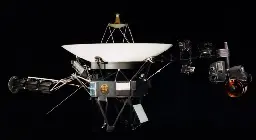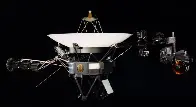Voyager 1 Team Accomplishes Tricky Thruster Swap
Voyager 1 Team Accomplishes Tricky Thruster Swap
The spacecraft uses its thrusters to stay pointed at Earth, but after 47 years in space some of the fuel tubes have become clogged.

Engineers working on NASA’s Voyager 1 probe have successfully mitigated an issue with the spacecraft’s thrusters, which keep the distant explorer pointed at Earth so that it can receive commands, send engineering data, and provide the unique science data it is gathering.
After 47 years, a fuel tube inside the thrusters has become clogged with silicon dioxide, a byproduct that appears with age from a rubber diaphragm in the spacecraft’s fuel tank. The clogging reduces how efficiently the thrusters can generate force. After weeks of careful planning, the team switched the spacecraft to a different set of thrusters.
The thrusters are fueled by liquid hydrazine, which is turned into gases and released in tens-of-milliseconds-long puffs to gently tilt the spacecraft’s antenna toward Earth. If the clogged thruster were healthy it would need to conduct about 40 of these short pulses per day.
Switching to different thrusters would have been a relatively simple operation for the mission in 1980 or even 2002. But the spacecraft’s age has introduced new challenges, primarily related to power supply and temperature. The mission has turned off all non-essential onboard systems, including some heaters, on both spacecraft to conserve their gradually shrinking electrical power supply, which is generated by decaying plutonium.
